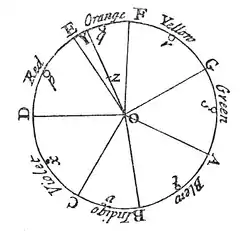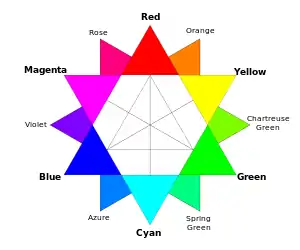ROYGBIV
ROYGBIV or Roy G. Biv is an acronym for the sequence of hues commonly described as making up a rainbow: red, orange, yellow, green, blue, indigo and violet. The initialism is sometimes referred to in reverse order, as VIBGYOR.


History

In Classical Antiquity, Aristotle claimed there was a scale of seven basic colors.[1] In the Renaissance, several artists tried to establish a new sequence of up to seven primary colors from which all other colors could be mixed. In line with this artistic tradition, Newton divided his color circle, which he constructed to explain additive color mixing, into seven colors.[2] His color sequence including the tertiary color indigo is kept alive today by the Roy G. Biv mnemonic. Originally he used only five colors, but later he added orange and indigo to match the number of musical notes in the major scale.[3][4]
The Munsell color system, the first formal color notation system (1905), names only five "principal hues": red, yellow, green, blue, and purple.[5]
Another traditional mnemonic device has been to turn the initial letters of seven spectral colors into a sentence. In Britain the most common is "Richard Of York Gave/Gained Battle In Vain." The mnemonic is said to refer to the defeat and death of Richard, Duke of York at the Battle of Wakefield.[6] Alternatively, the biblically inspired "Read Out Your Good Book In Verse," or the more anarchic "Rinse Out Your Granny's Boots In Vinegar," may be used.
In popular culture
- "Roygbiv" is a song by Boards of Canada, featured on their albums Boc Maxima (1996)[7] and Music Has the Right to Children (1998).[8]
- The "Richard Of York Gave Battle In Vain" mnemonic appears in "Richard of York", a song by Simon Bookish in his Unfair/Funfair (2006) album.[9]
- The band Public Service Broadcasting has a song entitled "ROYGBIV" on their 2013 album Inform-Educate-Entertain.[10]
- The alternative rock band They Might Be Giants included a song entitled "Roy G. Biv" on their 2009 children's album Here Comes Science, which describes the visible spectrum using the device of an elf who lives inside the rainbow.
- The DC Comics fictional universe has a supervillain called Rainbow Raider, whose real name is Roy G. Bivolo.
- The 1993 video game Kirby's Adventure consists of levels located in worlds whose names' first initials spell out VIBGYOR.
References
- MacAdam, David L. (1970). Sources of Color Science (from Metereologica III.2.4). Mit Press. p. 9. ISBN 0262130610. OL 4574886M.
white, yellow, red, green, blue, purple and black
- Newton, Isaac (1704). Opticks.
- "SHiPS Resource Center || Newton's Colors". .umn.edu. Archived from the original on 2014-09-29. Retrieved 2014-05-24.
- Hutchison, Niels (2004). "Music For Measure: On the 300th Anniversary of Newton's Opticks". Color Music. Archived from the original on 2017-01-18.
- Cleland, T. M. "The Munsell Color System - A Practical Description With Suggestions for Its Use". ApplePainter.com. ApplePainter.com. Retrieved 3 August 2020.
- Surdhar, Christina (2 September 2013). Bloody British History: York. History Press. p. 56. ISBN 9780750951593. Retrieved 29 December 2017.
- "Boards Of Canada – Boc Maxima". Discogs. Retrieved 2019-08-15.
- "Boards Of Canada – Music Has The Right To Children". Discogs. Retrieved 2019-08-15.
- Bookish, Simon. "Richard of York". Bandcamp. Retrieved November 20, 2018.
- "PUBLIC SERVICE BROADCASTING - ROYGBIV". YouTube. Archived from the original on 1 April 2016. Retrieved 2 August 2017.

